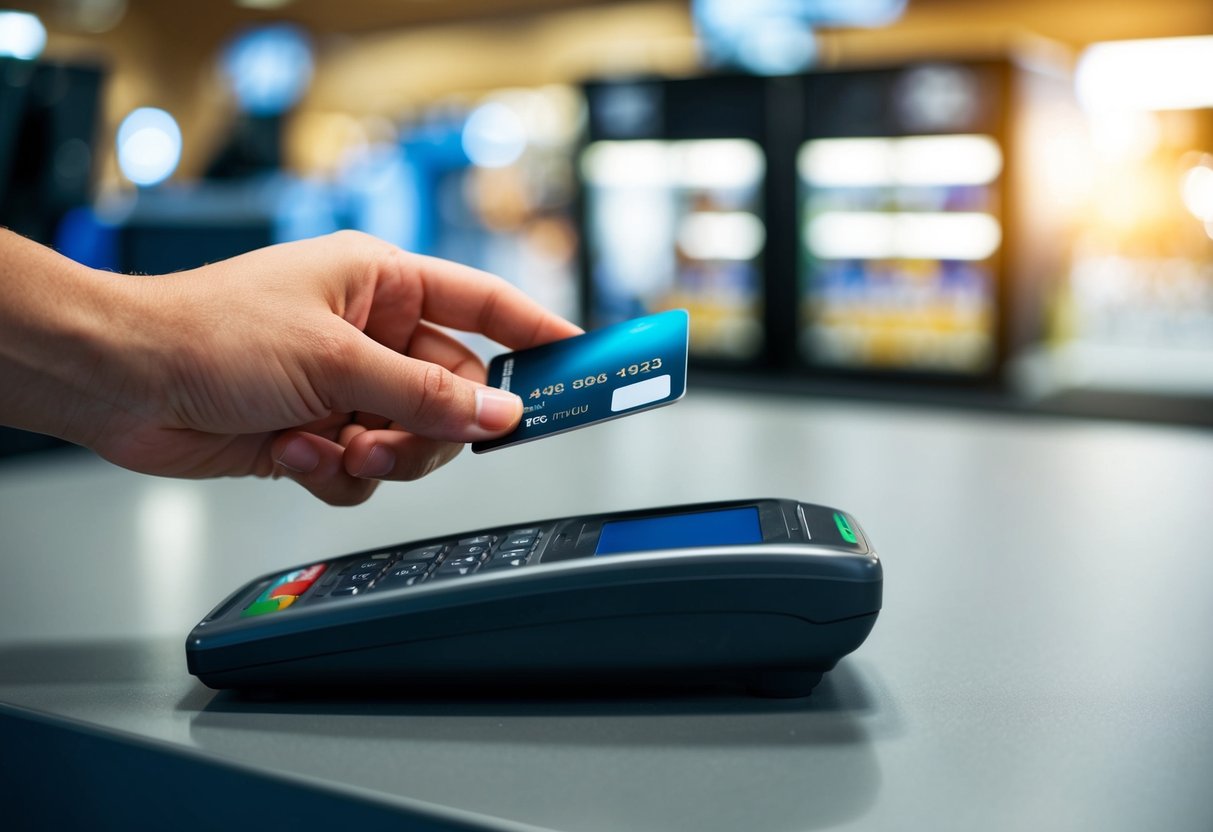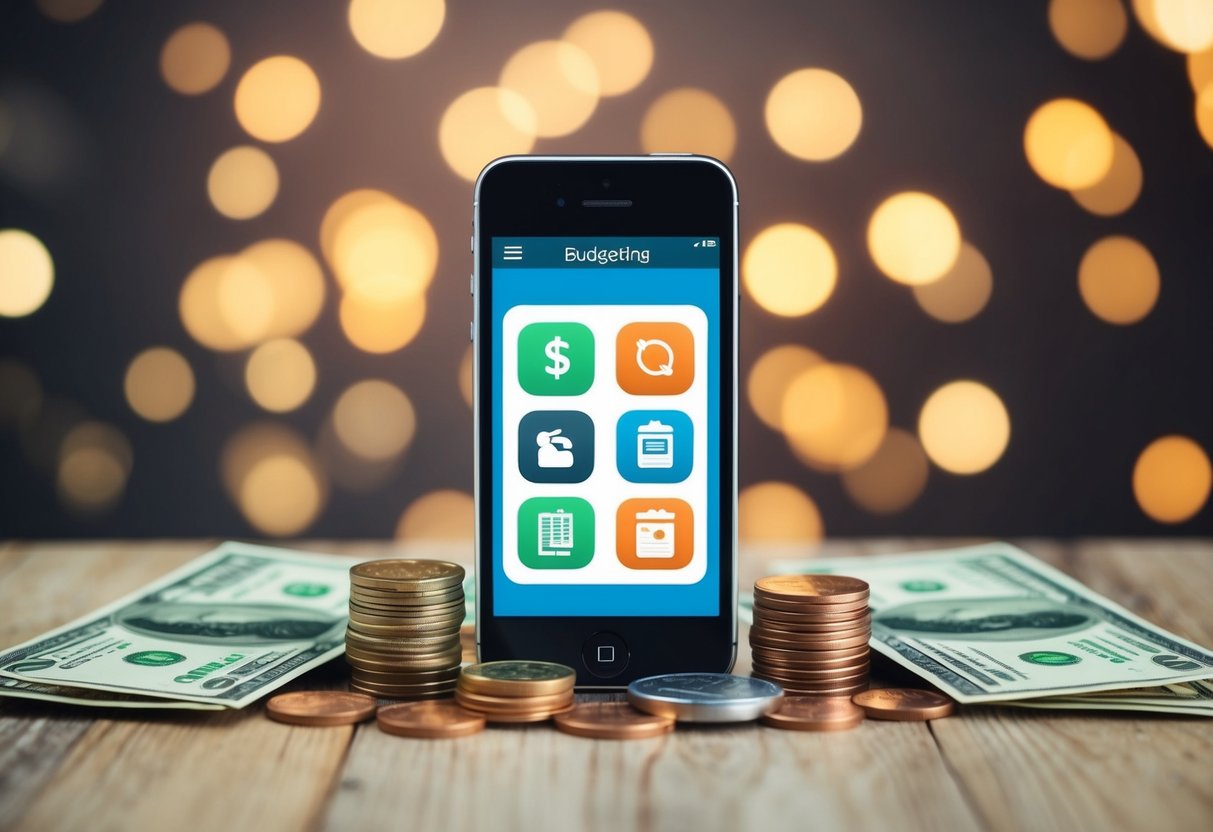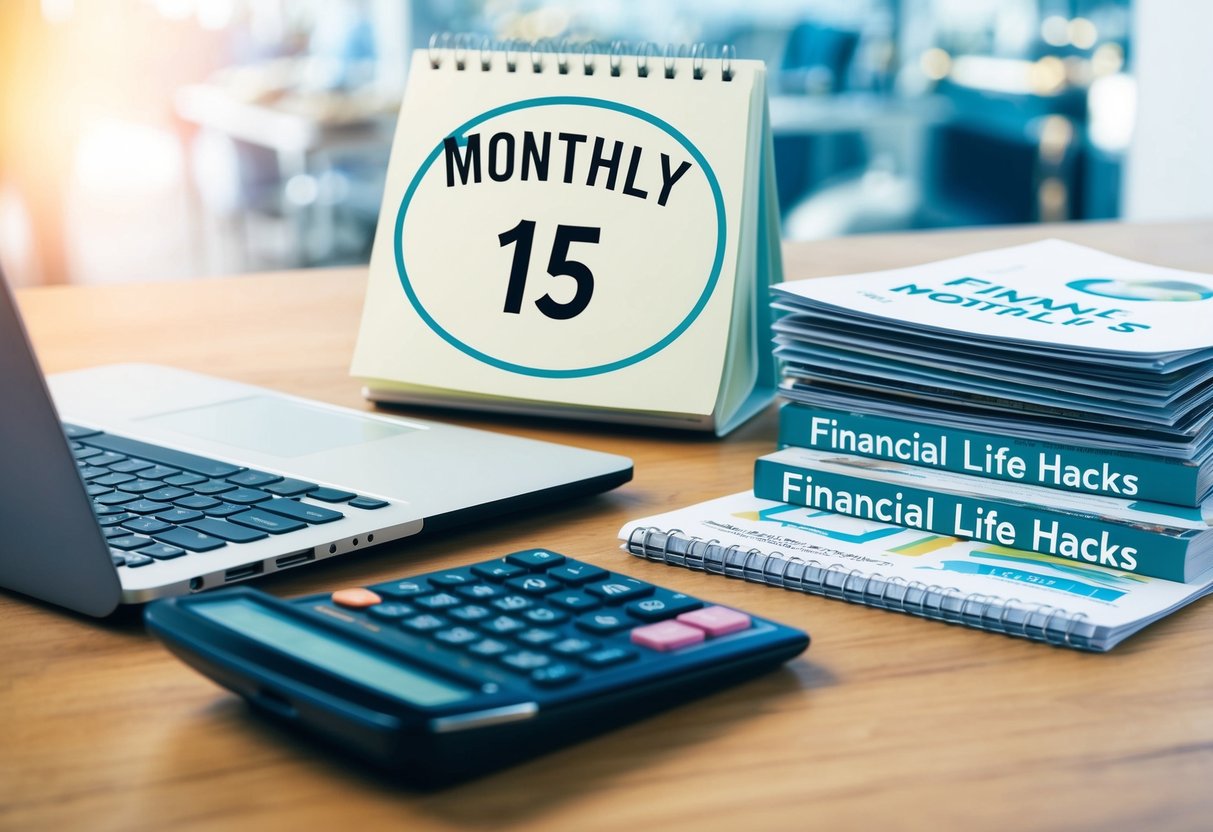I'm excited to share some financial life hacks can make managing money feel a lot less daunting. Throughout this article, I'll touch on 15 practical tips designed to help streamline finances and make savings more achievable.

Table of Contents
Money management sometimes feels overwhelming, but with a few strategic changes, it can become empowering and rewarding. These life hacks will aim to simplify the financial aspect of daily life, making it easier to achieve goals and live comfortably. I look forward to exploring these strategies that can help us all better manage our money.
1) Use cashback credit cards

I love using cashback credit cards for everyday purchases. It feels great knowing I'm earning something back on the money I spend. These cards usually offer a percentage back on each purchase, which I can either redeem for cash or use as a statement credit.
One trick I use is taking advantage of the bonus categories some cards offer. By using different cards with bonus categories like groceries or dining, I can maximize my cashback rewards.
This means I get more value out of my spending without changing my habits.
Integrating my cashback rewards into my financial planning is another way I make the most of them. By investing this cashback or putting it toward savings goals, I ensure the money is put to good use. It's a simple yet effective way to strengthen my financial health.
Automate Savings Transfers

One of the easiest ways to save money is to automate savings transfers. I set up automatic transfers from my checking account to my savings account, ensuring my savings grow consistently without much effort.
By doing this, saving becomes a regular part of my financial routine.
Every month, a specific amount moves from my checking to my savings automatically. This way, I avoid the temptation to spend the money elsewhere. It provides a sense of security knowing that I am actively working towards my financial goals.
Direct deposit is another useful tool. Part of my paycheck automatically goes into my savings, reducing the chance of me spending the money first.
Automating savings transfers helps me build my financial future effortlessly and ensures I stay on track with my savings targets.
3) Buy in bulk for discounts

I’ve found that buying in bulk can be a great way to save money on non-perishable items. It’s amazing how much cheaper per unit things like rice, pasta, or even toilet paper can be when purchased in larger quantities.
This way, I can save a good bit over time on items I use regularly.
Of course, it's important to plan purchases to ensure I’m not wasting money on things I won’t use before they go bad.
I like to focus on products with long shelf lives. Items like canned goods, grains, and household supplies are perfect candidates for bulk buying.
Another tip I follow is to check for sales and maybe even split larger purchases with friends or family.
This way, the cost is shared, making it more budget-friendly. Plus, I get to enjoy the benefits of a lower unit price without the upfront cost being too high!
4) Compare insurance quotes annually
I make it a point to review my insurance quotes every year. Prices and policies can change considerably over time, and it’s worth seeing if I can save some money.
Besides, my financial situation and coverage needs might also change, influencing the type of insurance I should have.
When I'm comparing quotes, I look for new discounts or better rates from my current provider. It's also an opportunity to evaluate different insurers.
Sometimes, another company has a deal that's too good to pass up. I try not to be complacent with long-standing policies.
By checking rates and terms annually, I ensure my coverage remains optimal without paying more than necessary.
This simple habit can lead to significant savings while also offering peace of mind that I have the right protection.
5) Use budgeting apps like Mint

Budgeting apps like Mint have helped me keep track of my finances without much hassle. They allow me to see all my accounts in one place.
With Mint, I can quickly categorize my expenses and monitor how and where I spend my money.
Mint sends me alerts for upcoming bills and unusual transactions, which helps me avoid any nasty surprises.
Having such insights right in my pocket makes staying on top of my financial game much easier.
Since Mint recently shut down, I've been looking into alternatives like Simplifi by Quicken. It's also great for budgeting with a user-friendly interface.
These apps are flexible and adapt to different budgeting styles, whether it’s zero-based budgeting or the 50/30/20 rule.
While no app replaces personal dedication, these tools are invaluable companions for better financial management.
6) Invest spare change with Acorns
One of my favorite financial tricks is using the Acorns app to invest my spare change. It's a simple way to grow my investments without even really noticing it.
Every time I make a purchase, Acorns rounds up my transaction to the nearest dollar and invests the difference. It's practically effortless.
Acorns acts as both a micro-savings platform and a robo-advisor, handling my investments automatically.
The app offers a variety of exchange-traded funds (ETFs) tailored to different risk levels and investment preferences.
I love how it takes the guesswork out of investing by selecting a portfolio based on my financial goals.
In addition to the spare change feature, Acorns provides recurring investment options.
I can set it to invest a little extra on a daily, weekly, or monthly basis. This flexibility allows me to boost my savings when I have a bit more to spare.
Plus, I enjoy earning rewards when I shop through their partner brands, which adds an extra bonus to my account.
7) Set up a high-yield savings account
I always aim to maximize my savings, so setting up a high-yield savings account is a smart move.
With interest rates significantly higher than traditional savings accounts, I can earn more money on the funds I deposit.
It's like giving my savings a boost without extra effort.
When choosing a high-yield savings account, I consider factors like the annual percentage yield (APY), minimum deposit requirements, and any potential fees.
Some accounts offer APYs up to 5.50%, which can make a noticeable difference over time. It’s important to read the fine print and ensure it suits my financial goals.
Online banks often offer competitive rates because their overhead costs are lower than brick-and-mortar banks.
That’s why I explore online options to find the best deal.
Setting up an account is usually straightforward. I can often do it from the comfort of my home without stepping into a branch. This convenience makes it even more appealing.
Maintaining a high-yield savings account is an easy method for enhancing my financial growth.
By parking my funds in an account with a strong APY, I make the most out of my hard-earned cash without taking significant risks.
8) Negotiate to lower interest rates
I like finding ways to save money, and one thing I've discovered is that negotiating lower interest rates on my loans and credit cards can really help.
It might sound intimidating at first, but it can lead to significant savings over time.
First, I gather all the necessary information about my financial situation. This includes my credit score, outstanding debt, and payment history.
By being well-prepared, I can present a strong case to my lenders.
Then, I reach out to my creditors or lenders and simply ask if they can offer me a better interest rate.
It's surprising how often they are willing to work with me to lower my rates, especially if I've been a reliable customer.
Persistence pays off in negotiations.
If at first, they don't offer me a lower rate, I remain friendly and patient.
Sometimes, exploring options like refinancing can also make a big difference in reducing interest costs.
Negotiating lower rates isn't just about saving money each month. It's about gaining financial flexibility and reducing the overall cost of my debts.
9) Review subscriptions monthly

I make a habit of reviewing my subscriptions every month to ensure I’m not spending money on services I no longer use. This helps me keep my budget in check.
By taking a close look at my bank statements, I identify any recurring charges that might have slipped through unnoticed.
It's amazing how easy it is to forget a subscription.
Often, I find trial offers turn into paid services that I didn't intend to continue. Canceling these unnecessary subscriptions can save a surprising amount of cash.
I also consider rotating services rather than subscribing to multiple platforms at once. This way, I enjoy what I want without feeling weighed down financially.
Sometimes, downgrading to a cheaper tier is all that's needed. Many services offer reduced pricing for essential features, keeping me satisfied while saving money.
When reviewing, I always ask myself if the subscription truly adds value to my life. If it doesn’t, it’s time to let it go.
Each month, I set a reminder to conduct this quick review. It keeps my finances transparent and helps me maintain control over my spending.
10) Cut utility costs with smart devices
I've found that using smart devices has been a game changer in reducing my utility bills.
Smart thermostats, for example, adjust the temperature based on my schedule, which prevents unnecessary heating or cooling when no one is home.
Additionally, smart plugs allow me to control appliances remotely, so I can turn off devices I accidentally left on. It's a convenient way to cut down on energy waste.
Another handy device is a smart lighting system. It lets me program lights to turn on or off at specified times, adding both convenience and efficiency. Plus, motion-sensor lights ensure that I'm only using electricity when needed.
Investing in smart home devices can sometimes be costly upfront, but I've noticed significant savings on my bills. They also offer peace of mind with their automation features.
Many utility companies offer rebates or discounts on these devices, which can help offset the initial purchase cost. It's worth checking with local providers to see what's available.
Leverage employer retirement contributions
When it comes to planning for my retirement, I always try to take advantage of my employer's retirement contributions.
Many employers offer matching contributions on retirement plans like a 401(k). This is essentially free money added to my savings.
I make it a point to contribute enough to get the full employer match. For instance, if my employer matches up to 5% of my salary, I ensure that I contribute at least that amount.
By leveraging these contributions, I'm significantly boosting my retirement savings without extra effort. It’s like having a partner chip in to help grow my future nest egg, making it a smart financial move.
12) Explore 0% APR balance transfers
I've found that exploring 0% APR balance transfers can be a smart financial move.
They allow me to pay off existing credit card debt without accruing extra interest, which can be a big relief. It's like hitting a pause button on interest, giving me more breathing room to manage my finances effectively.
Many credit cards offer introductory periods with 0% APR for balance transfers.
These promotional periods typically range from 12 to 21 months, which lets me pay down the principal balance faster.
By focusing on the amount I owe instead of just interest, I can make progress more swiftly.
During this promotional window, I need to make payments diligently. This ensures that I won't encounter high interest rates once the offer period ends. It's all about discipline and effectively managing my expenses while I have this opportunity.
One thing I keep in mind is the balance transfer fee.
Even though these offers come with a brief interest-free period, a fee is charged for the transfer itself. The typical fee is around 3% to 5% of the transfer amount, so I need to check if the savings on interest outweigh this cost.
13) Utilize tax-advantaged accounts
Using tax-advantaged accounts is one of my favorite financial life hacks.
These accounts offer significant tax benefits that help in saving more effectively.
By making tax-deductible contributions and enjoying tax-free growth or withdrawals, I can maximize my savings for retirement.
There are several types of tax-advantaged accounts available, each designed for specific financial goals.
My 401(k) plan allows me to set aside a portion of my income with potential employer matching, which is a great boost.
Additionally, individual retirement accounts (IRAs) provide even more avenues to save with tax advantages.
Roth accounts are another savvy option where I may not get upfront tax deductions, but my withdrawals in retirement are tax-free.
This flexibility can be beneficial to manage taxes across different life stages.
Taking full advantage of these accounts can create a powerful strategy for long-term financial growth.
14) Choose a no-fee checking account
I always appreciate saving money where I can, and a no-fee checking account is a simple yet effective tool for this.
By choosing an account without monthly fees, I can keep more of my money for other expenses. These accounts typically offer features like no minimum balance requirements.
Many no-fee checking accounts also include perks.
For example, some provide unlimited ATM fee reimbursements, which is great if I often need cash on the go. Others might offer rewards or cashback, allowing me to earn while I spend.
When I shop around for a checking account, I focus on finding one that suits my lifestyle and offers convenience.
It's important to consider the bank's ATM network, online banking features, and mobile app quality. These considerations ensure that I choose an account that fits seamlessly into my daily routine.
15) Learn basic DIY repairs
Learning basic DIY repairs can be an effective way to save money.
I've found that simple skills, like caulking, make a big difference in my home’s energy efficiency. A bit of time spent sealing air leaks helps reduce my energy bills.
Doing small repairs by myself keeps me from spending on professional services.
Whether it's fixing a leaky faucet or replacing a broken tile, I gain a sense of accomplishment from tackling projects on my own. Plus, I get to learn useful skills along the way.
Online resources and tutorials come in handy for guiding me through different repairs.
I often watch videos or read articles that provide step-by-step instructions. It's amazing how accessible and easy to follow these resources can be for DIY enthusiasts like me.
Building a toolkit with basic items makes repairs easier and more efficient.
I make sure to keep essential tools like a hammer, nails, and a caulk gun handy. This way, I’m prepared for any minor fixes that come up around the house, and I avoid the hassle of last-minute trips to the store.
Understanding Financial Life Hacks
Financial life hacks are practical strategies designed to improve the way we handle money. These hacks focus on saving, budgeting, and efficiently managing finances to boost overall wealth.
Definition and Purpose
When I talk about financial life hacks, I mean simple yet effective strategies geared towards maximizing the efficiency of personal financial management.
These are techniques designed to help me save money, minimize waste, and ultimately achieve my financial goals.
The purpose of these hacks is to streamline financial processes, making them less cumbersome and more rewarding.
By adopting these hacks, I can create a more structured approach to managing my income, controlling expenses, and increasing my savings.
Why They're Important
Incorporating financial life hacks into my everyday routine is crucial because they offer practical ways to enhance financial well-being.
They help me avoid unnecessary expenses, plan for my future, and make the most out of every dollar earned.
These hacks provide guidance on handling debt, managing budgets, and finding bargains.
They also encourage smarter spending habits and foster a savings-oriented mindset.
As a result, I'm able to reduce financial stress, stabilize my finances, and secure long-term financial health.
Common Myths
Some common myths about financial life hacks suggest they are complicated or only for those who are good with money.
In reality, these hacks are accessible to everyone and offer simple ways to improve my finances without needing special skills.
There's also a misconception that financial hacks require drastic lifestyle changes. Many hacks can be integrated into my daily routine with minimal effort.
Understanding these myths helps me appreciate the real impact these hacks can have on boosting my financial stability.
How to Implement Financial Life Hacks
Implementing financial life hacks involves setting specific goals, tracking progress, and making strategic adjustments.
By being clear about what I want to achieve, monitoring my actions, and being flexible with my plans, I maximize financial success.
Setting the Right Goals
When I set financial goals, being specific is key.
I focus on specific, measurable targets rather than vague intentions.
For instance, rather than saying I want to save more, I set an objective to save $500 a month for a vacation.
Time-bound goals keep me accountable and motivated.
Writing down these goals and breaking them into actionable steps helps keep things clear and manageable.
By defining what success looks like, I can recognize achievements and stay motivated.
Tracking Your Progress
To track progress, I find it helpful to use a spreadsheet or an app to monitor expenses and savings.
Consistent tracking reveals spending patterns and where I can cut back.
It's useful to review financial activity every week or month.
By closely observing my spending and savings, I can see if I'm moving closer to my goals or need to adjust my plans.
Visibility over where my money goes is crucial for making informed financial decisions.
Adjusting Strategies Over Time
As life changes, financial strategies should evolve too.
I reassess my goals and strategies regularly. I do this especially after big life events like moving or changing jobs.
If one saving method isn't effective, I'm open to trying new approaches.
Regular reviews help me ensure that my financial planning aligns with my current circumstances and future desires.
Flexibility in adjusting my plans is key to successfully managing my finances over the long term.
